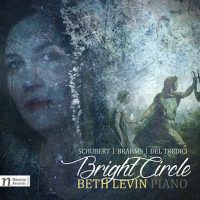Odes to Music
|
Gil Reavill [April 2017.]
“Bright Circle.” Franz SCHUBERT: Piano Sonata No. 20, D. 959 (1828). Johannes BRAHMS: Variations and Fugue on a Theme by Handel, Op. 24 (1861). David DEL TREDICI: Ode to Music (2015). Beth Levin (pno). Navona Records NV6074 (1 CD) (http://www.navonarecords.com/). Creative promiscuity might be the dirty little secret that informs all art. “Immature poets imitate; mature poets steal,” stated T.S. Eliot, who should know, the great modernist having looted the stacks of many a classical library in his day. Bright Circle, Beth Levin’s stirringly beautiful new album of solo piano, dedicates itself to the foundational idea that composers are forever building on artistic traditions and creative elements that came before. The three works on display all loop back to other works in ways openly declared or subtly expressed, establishing a bright circle indeed, one of influence, cross-fertilization, and, yes, a little red-handed theft. Here are giants standing on the shoulders of other giants. Variations and Fugue on a Theme by Handel, Op. 24, by Johannes Brahms, takes center stage in the album’s program, framed by a late Schubert sonata and David Del Tredici’s witty modern take on that composer’s An die Musik. The Brahms Variations assumes its place among Levin’s impressive recent recordings of other sets of variations, including the Goldbergs of Bach and the Diabellis of Beethoven, indicating that she either possesses a fearless heart or is a glutton for punishment, perhaps a little of both. No pain is evident in Levin’s approach to Brahms — her playing here is assured, buoyant, untroubled, as though it were being performed in sunlight. Beginning with what amounts to a minor Baroque flourish in the third movement aria of Handel’s Harpsichord Suite No. 1 in B-flat major, Brahms breathes exuberant new life into the theme as surely as if he were a lifeguard resuscitating a drowning swimmer. The composer, then 28 and in the bumpy first stage of his career, virtually erupts in melodies, from the gentle rain patter of the opening aria to the bring-down-the-house fugue that closes the piece. I was impressed that Levin’s inspired, transparent interpretation dispensed with artifice and got out of the way of the music — no mean feat, that — allowing us to witness the creative sparks that fly when one genius ricochets off another. Other figures circle around the work, too: From Schubert, Brahms took lessons in structural development based on melodic variation. How fine that Levin included David Del Tredici’s marvelous Ode to Music on the album, a creative choice that effectively illuminates the other two pieces on the roster. Del Tredici and Levin have long been collaborators, and their artistic alliance has yielded delicious fruit before, including pieces composed specifically for the pianist. Not a variation but a musical meditation upon the gorgeous valedictory Schubert lied, An die Musik (“To Music”), Ode to Music had its world premiere in 2015. Levin’s treatment teases out the romantic underpinnings among Del Tredici’s disruptions of cadence and harmony, his droll quotations and startling mash-ups. Pulled-apart-and-put-together as the piece is (the title itself is a playful redundancy), the listener will be delighted to find Schubert in it, and Levin’s insistent, intelligent phrasing honors the tragic genius’s ghostly presence. And Schubert himself, isn’t it often claimed that he stood alone, a shooting star who reflected the light of no other? Yet the bright circle of influence, interpretation and inspiration can be heard in Levin’s Sonata in A major. In reality no man — and no composer — is an island. Refulgent hints of Mozart, while not immediately established, nevertheless work their way into the listener’s consciousness in the sonata’s extended melodic lines. Of course, Schubert’s main source of plunder was always himself, and there are lifts from various lieder, plus phrases from an earlier sonata here, and an impromptu there. Schubert’s great String Quartet in C major, composed during the same period as the Sonata in A major, is at least in some sense a response to Beethoven’s towering String Quartet No. 14, and I caught string-quartet qualities throughout the sonata, again elusive as fireflies. Levin has visited Schubert’s last three piano sonatas before, having previously recorded the Sonata in C major. She can connect to his disparate influences while still capturing the composer’s haunting, inimitable textures of loneliness and isolation. Tinker to Evers to Chance. Mozart to Beethoven to Schubert. Handel to Brahms, Schubert to Del Tredici. An ever widening, ever brighter circle. Levin’s deep conversancy with the Romantic canon informs her spirited approach to both modern and period works. She is thus the perfect player to convey the music on Bright Circle, pieces with deep cross currents and wide-ranging influences. Nota bene: Full disclosure, I am a friend of Beth Levin’s and a longtime fan of her work. Unabashed enthusiast that I am, it will be obvious from the preceding that I’m also a tone-deaf musical neophyte, especially in technical terms. So take every word here not with a grain but a whole pillar of salt.
[More Gil Reavill]
[Previous Article:
Farinelli’s Last City]
[Next Article:
Used Bin Troll Tweets Z.]
|
